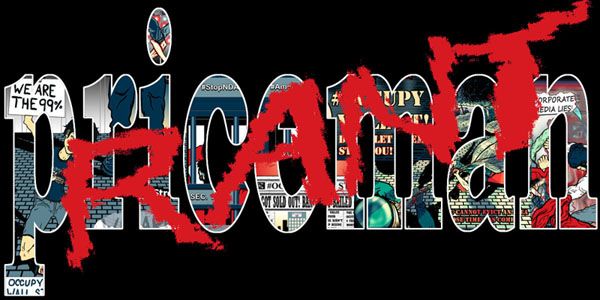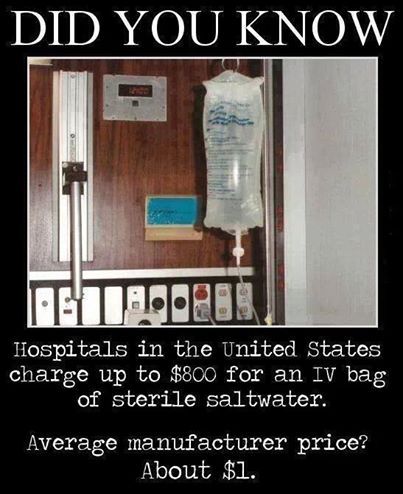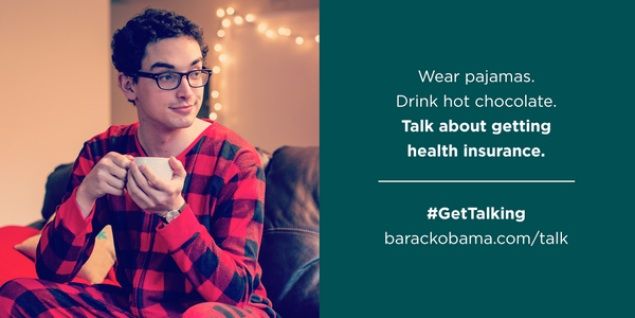
Here's a small example of the criminal price gouging at hospitals that should require a RICO investigation if we were serious about controlling health care costs brought to you from US Uncut:


Mar 05 2014

Here's a small example of the criminal price gouging at hospitals that should require a RICO investigation if we were serious about controlling health care costs brought to you from US Uncut:

Jan 02 2014
Passing the racket onto an intermediary and then dumping it on the consumer is part of the scam. Medicare needs full market share so it can bring all the prices down since no one will RICO Act providers, for profit hospitals, and insurance companies passing that cost in addition to 13% extra for administration costs onto you even with the ACA. Forcing you to participate in this scam is what we call Obamacare.
Dec 19 2013
Somebody at Organizing For America (aka Obama For America, OFA) thought that a twitter campaign featuring a be-speckled twenty something wearing plaid pajamas would be a good way to #GetTalking about the Affordable Care Act (aka Obamacare).


Until the the “reality based” twitter community decided to counter the White House propaganda machine with their own version of #PajamaBoy


h/t to RainbowGirl @ Corrente
Dec 01 2013
 This week has a certain nostalgia for me. I am working the last four shifts in my home, Humboldt County. Nestled between pristine redwoods and dramatic cliffs overlooking the west coast of California, I want to stay here, but cannot. I am feeling the full force of the United States health care crisis. In the four years I have worked here eight of ten obstetricians in the southern half of the county have left, and now I find I am one of them.
This week has a certain nostalgia for me. I am working the last four shifts in my home, Humboldt County. Nestled between pristine redwoods and dramatic cliffs overlooking the west coast of California, I want to stay here, but cannot. I am feeling the full force of the United States health care crisis. In the four years I have worked here eight of ten obstetricians in the southern half of the county have left, and now I find I am one of them.
Two obstetricians, far apart geographically and serving two different hospitals, are all that is left to serve an area once supporting 10 obstetricians. Both doctors are men over 60, who have a tough future ahead of them. Without outside help there is no way they can see all the patients that will need them. They have to remain within 30 minutes of the hospital and can be told to come to work any time of the day or night. They can never have a moment off, a full night’s sleep, a drink of alcohol to ring in the New Year. Watching a full length movie, or having a nice dinner with the spouse without interruption is a thing of the past. Neither of the remaining doctors can get sick or injured. This is really asking them to be super human and there is no cavalry on their horizon. In fact, if Catholic Health Systems is successful at closing one of the two hospitals, only one physician will remain.
As a young person, I wanted to take my medical skills to a disadvantaged third world nation. Looks like I got my wish – right here in the US. How did we get here?
Jul 05 2012
I haven’t paid too much attention to this uproar since I feel it is a distraction to the issue of real health care reform. But since everyone seems to think it’s significant, I will let our readers decide.
CBS News’ reporter Jan Crawford reported that Chief Justice John Roberts had switched his vote on the individual mandate, supporting it under the right of Congress to levy taxes, allowing the Health Care Law to stand.
After the historic oral arguments in March, the two knowledgeable sources said, Roberts and the four conservatives were poised to strike down at least the individual mandate. There were other issues being argued – severability and the Medicaid extension – but the mandate was the ballgame. [..]
On this point – Congress’ commerce power – Roberts agreed. In the court’s private conference immediately after the arguments, he was aligned with the four conservatives to strike down the mandate.
Roberts was less clear on whether that also meant the rest of the law must fall, the source said. The other four conservatives believed that the mandate could not be lopped off from the rest of the law and that, since one key part was unconstitutional, the entire law must be struck down.
Because Roberts was the most senior justice in the majority to strike down the mandate, he got to choose which justice would write the court’s historic decision. He kept it for himself.
Over the next six weeks, as Roberts began to craft the decision striking down the mandate, the external pressure began to grow. Roberts almost certainly was aware of it. [..]
It is not known why Roberts changed his view on the mandate and decided to uphold the law. At least one conservative justice tried to get him to explain it, but was unsatisfied with the response, according to a source with knowledge of the conversation. [..]
Never mind the ramifications on the limits the ruling puts on Congress’ ability to regulate interstate commerce, it completely ignored precedent (Wickard v Filburn). Roberts’ siding with the conservatives drew the ire of Senator Charles Schumer (D-NY):
Although he upheld the health care law on another basis, Roberts sided with the court’s four conservatives in declaring that Congress may not, under the Commerce Clause, force people to engage in a market transaction. The five-member majority view effectively rewrites existing law. It’s the first time since before the 1942 case Wickard v. Filburn, a precedent that was affirmed in the 2005 case Gonzales v. Raich, that the Supreme Court has placed a limit on Congress’s authority make national economic regulation that substantially affects interstate commerce.
In 2005, during Roberts’ confirmation hearing, Schumer grilled the soon-to-be chief justice on whether he would support the legal framework established by Wickard.
“Now it was reaffirmed in the Raich case and that is a precedent of the court, just like Wickard, that I would apply like any other precedent,” Roberts said at the time. “I have no agenda to overturn it. I have no agenda to revisit it. It’s a precedent of the court.”
TPM asked Schumer whether Roberts went back on his word in the ‘Obamacare’ decision.
“Yes he did,” the senator said. “If you read his testimony about Wickard, about some of the other, more recent Commerce Clause cases at the hearing, and looked at what he said here, it’s quite different.”
But the news media and some pundits are far more interested in who leaked the story
But who are those two sources?
GWU Law professor Orin Kerr, the one who got the ball rolling on this discussion, notes that Crawford’s story has details “only the justices and their clerks would likely know.”
“The leaks go into what the justices were thinking and what signal they meant to send with their actions,” he argues (and provides evidence – but you should read the story because there’s plenty). “Further, I doubt Crawford would run with a story with that kind of detail that was sourced less directly. So my best guess would be that the two sources she relies on are from the among the justices and their clerks.”
But Kerr rules out the clerks, simply because a clerk would be “crazy” to leak. “A clerk who leaked this and is identified has likely made a career-ending move. … Even assuming a clerk or two was so extraordinarily dismissive of the confidentiality rules to leak this, it would be nuts to leak over the weekend when you have to show up at the court for work tomorrow.”
Then law professor Paul Campos wrote this piece for Salon.com suggesting that there us strong evidence that Roberts penned both decisions:
It’s notable that Crawford’s sources insist on the claim that the joint dissent was authored specifically in response to Roberts’ majority opinion, without any participation from him at any point in the drafting process that created it. It would, after all, be fairly preposterous for the four dissenters to jointly “author” an opinion that was in large part written originally by the author of the majority opinion to which the joint dissenters were now so flamboyantly objecting.
Yet that, I am told by a source within the court with direct knowledge of the drafting process, is exactly what happened. My source insists that “most of the material in the first three quarters of the joint dissent was drafted in Chief Justice Roberts’ chambers in April and May.” Only the last portion of what eventually became the joint dissent was drafted without any participation by the chief justice.
This source insists that the claim that the joint dissent was drafted from scratch in June is flatly untrue. Furthermore, the source characterizes claims by Crawford’s sources that “the fact that the joint dissent doesn’t mention [sic] Roberts’ majority … was a signal the conservatives no longer wished to engage in debate with him” as “pure propagandistic spin,” meant to explain away the awkward fact that while the first 46 pages of the joint dissent never even mention Roberts’ opinion for the court (this is surely the first time in the court’s history that a dissent has gone on for 13,000 words before getting around to mentioning that it is, in fact, dissenting), the last 19 pages do so repeatedly.
University of Colorado law professor Paul Campos broke the news on the Last Word that, according to his sources inside the Supreme Court, Chief Justice John Roberts wrote both opinions in the case involving President Obama’s health care reform law. MSNBC host Lawrence O’Donnell is rejoined by Prof. Campos and author Glenn Greenwald to take about the leaks, Roberts’ vote and what it say about the institution of the Supreme Court.
So the right is flipping out because Roberts voted with the “liberal” justices to uphold the law based on a twisted view that the penalty for not buying health care insurance is a tax. The so-called “left” is cheering but totally misses the long term problems this ruling has created. I still say the “leaks and who did the leaking” is a tempest in a tea pot that is distracting from the main issue that this country needs universal health care.
Recent Comments